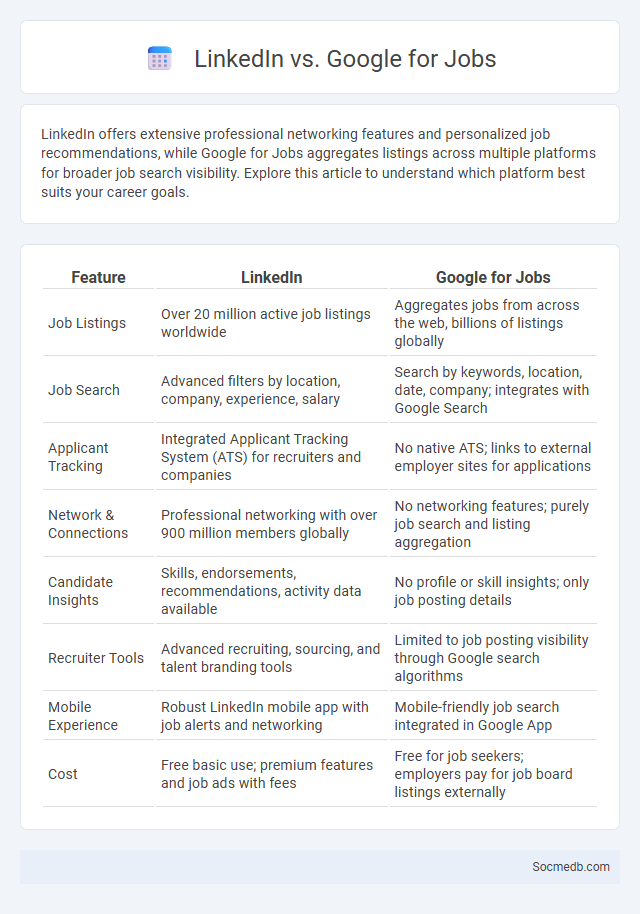
Photo illustration: LinkedIn vs Google for Jobs
LinkedIn offers extensive professional networking features and personalized job recommendations, while Google for Jobs aggregates listings across multiple platforms for broader job search visibility. Explore this article to understand which platform best suits your career goals.
Table of Comparison
| Feature | Google for Jobs | |
|---|---|---|
| Job Listings | Over 20 million active job listings worldwide | Aggregates jobs from across the web, billions of listings globally |
| Job Search | Advanced filters by location, company, experience, salary | Search by keywords, location, date, company; integrates with Google Search |
| Applicant Tracking | Integrated Applicant Tracking System (ATS) for recruiters and companies | No native ATS; links to external employer sites for applications |
| Network & Connections | Professional networking with over 900 million members globally | No networking features; purely job search and listing aggregation |
| Candidate Insights | Skills, endorsements, recommendations, activity data available | No profile or skill insights; only job posting details |
| Recruiter Tools | Advanced recruiting, sourcing, and talent branding tools | Limited to job posting visibility through Google search algorithms |
| Mobile Experience | Robust LinkedIn mobile app with job alerts and networking | Mobile-friendly job search integrated in Google App |
| Cost | Free basic use; premium features and job ads with fees | Free for job seekers; employers pay for job board listings externally |
Introduction: Navigating the Modern Job Search Landscape
Social media platforms have transformed how employers and job seekers connect, making your online presence crucial in the modern job search landscape. Leveraging LinkedIn, Twitter, and industry-specific networks can increase visibility and access to unadvertised opportunities. Crafting a professional digital identity enhances your chances of standing out to recruiters and potential employers.
Overview: LinkedIn, Google for Jobs, and Employer Branding Defined
LinkedIn is a professional networking platform essential for employer branding and talent acquisition, offering tools to showcase company culture and job opportunities. Google for Jobs enhances recruitment visibility by aggregating job listings across multiple platforms, driving more qualified candidates to your openings. Employer branding defines how your company is perceived by potential employees, combining online presence and social media strategy to attract and retain top talent.
Reach and Audience: Where Are the Candidates?
Candidates targeting social media platforms strategically prioritize channels with the highest user engagement and demographic alignment, such as Instagram for younger voters and Facebook for a broader age range. Data analytics reveal where campaign messages gain maximum traction, enabling tailored content that resonates with specific voter segments. Understanding audience distribution across platforms optimizes reach and enhances overall campaign influence.
User Experience: Application Processes Compared
Social media platforms prioritize streamlined application processes that enhance user experience by minimizing steps and integrating intuitive interfaces. Features such as single sign-on (SSO), biometric authentication, and real-time onboarding guidance significantly reduce friction and drop-off rates. Comparative analyses reveal that platforms employing multi-factor authentication combined with simple design achieve higher user retention and satisfaction metrics.
Candidate Quality: Attracting Top Talent
Attracting top talent through social media requires a strategic approach that highlights your company's culture, values, and career growth opportunities. Leveraging platforms like LinkedIn, Twitter, and Instagram allows you to engage with highly qualified candidates by showcasing employee testimonials and success stories. Optimizing your social media presence ensures your brand stands out, increasing the likelihood of attracting candidates who align with your organization's goals and expertise.
Cost and ROI: Investment vs. Outcome
Investing in social media marketing requires careful analysis of cost and return on investment (ROI) to ensure efficient use of budget. Platforms like Facebook and Instagram offer targeted advertising options that can yield higher ROI through precise audience segmentation and engagement metrics. Measuring outcomes using tools such as conversion tracking and analytics dashboards helps optimize spending by identifying the most profitable campaigns and content strategies.
Branding Opportunities: Showcasing Company Culture
Social media platforms offer unparalleled branding opportunities by showcasing company culture through authentic content such as behind-the-scenes videos, employee testimonials, and day-in-the-life stories. Highlighting core values and work environment on channels like Instagram, LinkedIn, and TikTok helps attract talent and engage customers by creating a relatable and transparent brand identity. Consistent cultural storytelling boosts brand loyalty and differentiates companies in competitive markets.
Analytics and Insights: Measuring Recruitment Success
Social media analytics provides detailed metrics on engagement, reach, and candidate behavior, enabling recruiters to assess the effectiveness of their campaigns. Tools like LinkedIn Talent Insights and Facebook Analytics offer real-time data to track applicant sources, conversion rates, and audience demographics. Leveraging these insights optimizes recruitment strategies by identifying high-performing channels and improving talent acquisition outcomes.
Integration and Compatibility: Tools and ATS Solutions
Social media integration with Applicant Tracking Systems (ATS) enhances recruitment efficiency by enabling seamless data sharing and candidate sourcing from platforms like LinkedIn, Facebook, and Twitter. Compatibility between ATS solutions and social media tools ensures real-time synchronization, automated candidate profile enrichment, and streamlined communication workflows. Leading ATS providers such as Greenhouse, Lever, and iCIMS prioritize robust API capabilities to support multi-channel recruitment strategies, improving talent acquisition outcomes.
Conclusion: Choosing the Right Strategy for Your Hiring Goals
Selecting the right social media strategy directly impacts your hiring success by targeting the best candidates efficiently. Platforms like LinkedIn provide professional networks, while Instagram and Facebook showcase company culture, helping attract diverse talent aligned with your goals. Tailoring your approach based on your unique hiring needs ensures maximum engagement and quality applicants.
 socmedb.com
socmedb.com